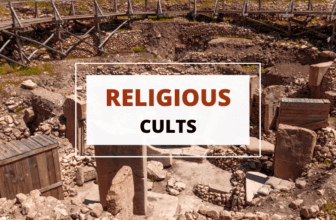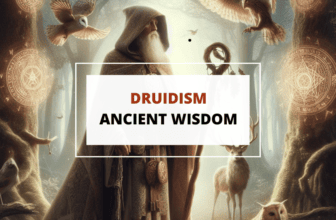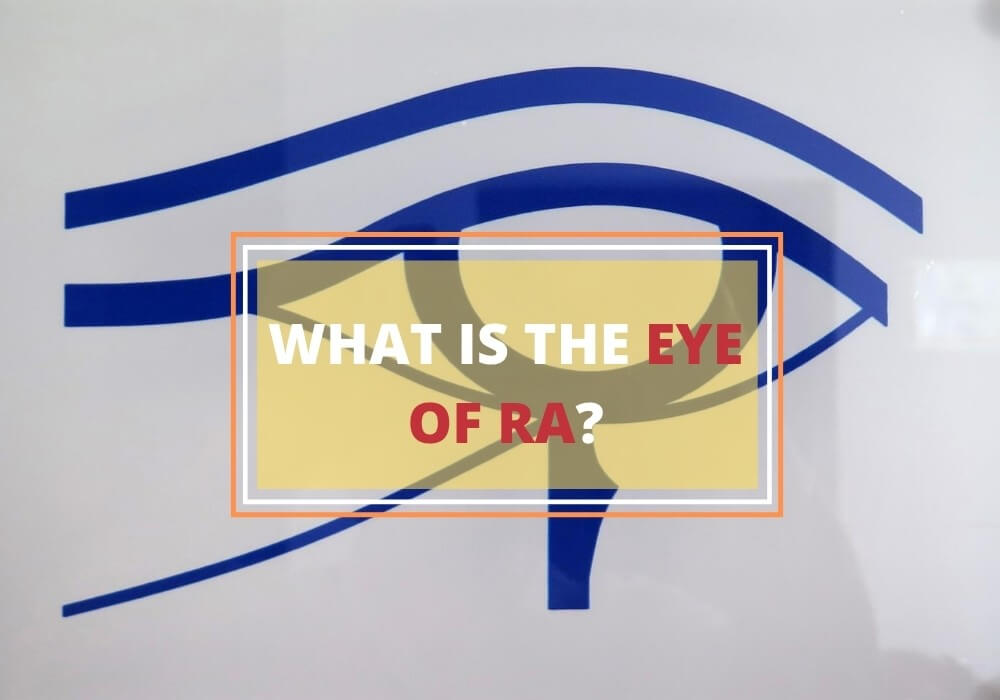
Table of Contents
The symbolic eye had an overwhelming presence in ancient Egyptian iconography. Not to be confused with the Eye of Horus, the Eye of Ra is often depicted as a stylized right eye with markings. Let’s take a look at some of the myths and legends to uncover what this symbol stood for.
What is the Eye of Ra?
The Eye of Ra is an ancient Egyptian symbol that stands for protection, royal authority, and health. It’s closely linked to the sun and seen as a part of Ra’s power, like he’s keeping an eye on the whole universe. In Egyptian myths, this eye often turns into a goddess.
Depending on the story, she might be Hathor, Sekhmet, Bastet, or Mut, each showing a different side of the Eye’s strength. You’ll spot this symbol a lot in Egyptian art, looking like an eye with a tear mark underneath, showing its connection to the divine and its role in keeping evil away.
People used the Eye of Ra a lot in amulets and decorations to keep themselves or their places safe and healthy. It’s a big deal in Egyptian culture, mixing a sense of awe and respect for the powers it represented.
History of the Eye of Ra
In ancient Egypt, having the eyes of a god meant having divine power. The Eye of Ra is super famous, just like the Eye of Horus, and people often mix them up. But they’re different: the Eye of Horus is a left eye, and the Eye of Ra is a right eye, belonging to different Egyptian gods.
Ra is the sun god and the start of everything, but the Eye of Ra is its own thing with a personality, kind of independent from Ra. It’s often called the “daughter of Ra” and was a big deal in ancient Egypt.
The Eye of Ra was linked to a bunch of Egyptian goddesses like Sekhmet, Hathor, Wadjet, and Bastet. It took on different roles in various Egyptian stories, acting as a mother, sister, and even a partner.
Sometimes, the Eye of Ra was seen as part of Ra’s massive power. It had this fierce, dangerous side, kind of like the burning heat of the sun. Ancient Egyptians respected this tough side of the symbol, using it for protection. That’s why you see the Eye of Ra on pharaohs’ amulets, artifacts, mummies, and tombs.
There’s this Egyptian story where Ra sends his eye to find his lost kids. When the eye brings them back, Ra grows a new one, and the old eye feels left out. To cheer it up, Ra turns it into a uraeus (a royal cobra) and wears it on his forehead. So, another way to show the Eye of Ra is with a solar disk surrounded by two cobras.
The Eye of Ra and Goddess Wadjet
Wadjet is closely linked to the Eye of Ra, especially since the Eye symbol includes two rearing cobras, known as Uraeus, which are symbols of Wadjet herself. Way before the sun god Ra became a big deal, Wadjet was already important. She was the main goddess for the ancient Lower Egypt region.
The Uraeus cobra symbol was a big fashion statement for Lower Egypt’s rulers for ages. When Lower and Upper Egypt joined up, Ra’s cult kind of took over Wadjet’s spot. But she still had a lot of influence in Egypt.
The Eye of Ra is often shown with a big bronze disk, representing the sun, and two Uraeus cobras on each side. In a lot of these pictures, one cobra is wearing the crown of Upper Egypt (called the Hedjet), and the other wears the crown of Lower Egypt (known as the Deshret).
Difference Between the Eye of Ra and the Eye of Horus
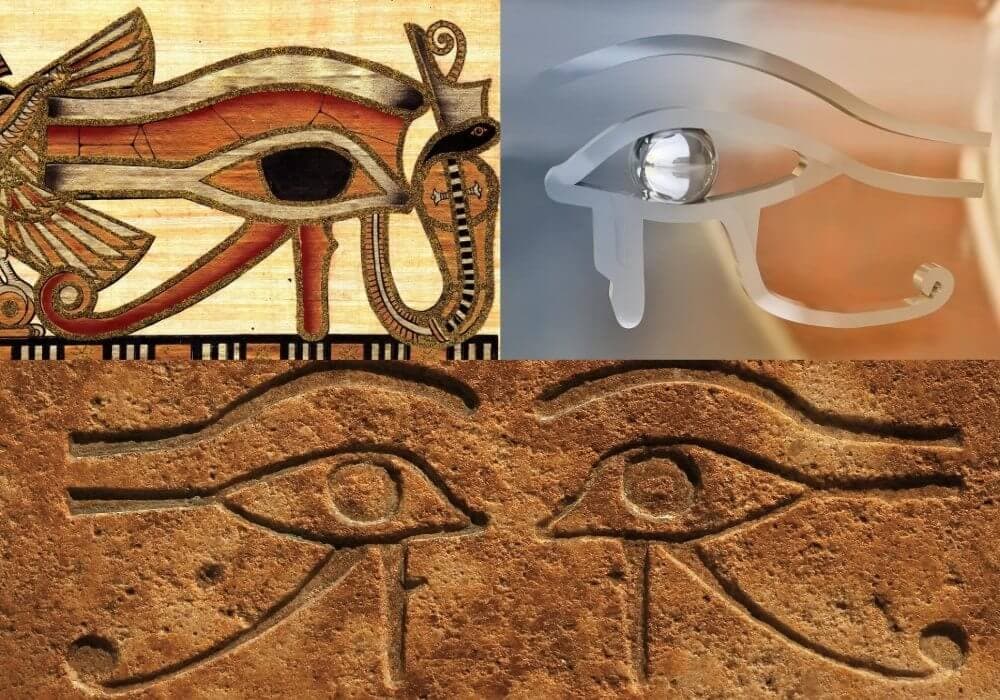
While the two are quite distinct, the Eye of Ra is a much more aggressive symbol than the Eye of Horus. In Egyptian mythology, the Eye of Horus has a legend of regeneration, healing, and divine intervention from the gods. On the contrary, the Eye of Ra is a symbol of protection rooted in fury, violence, and destruction.
Usually, the Eye of Ra is depicted as the right eye, and the Eye of Horus as the left eye, but no rule can be applied universally. According to the Hieroglyphs and Arithmetic of the Ancient Egyptian Scribes, “In many Egyptian murals and sculptures the right eye became known as the Eye of Horus… and museums all over the world contain amulets of both the left and right Eye of Horus.”
Also, the Eye of Horus belongs to a different god, Horus, and is commonly (but not always) depicted with a blue iris. On the other hand, the Eye of Ra commonly sports a red iris. Both eyes symbolize protection, but the way this protection is demonstrated separates the two.
Meaning and Symbolism of the Eye of Ra
The Eye of Ra is a big deal in ancient Egyptian mythology. It’s all about the sun god Ra’s power, standing for protection, royal strength, and healing. Think of it as Ra keeping an eye on the world, shining light and life but also having the power to destroy. This symbol is tied to the sun’s fierce heat and light, seen as strong forces that keep evil away.
In Egyptian myths, the Eye of Ra isn’t just a thing; it often becomes a goddess. She could be Hathor, Sekhmet, Bastet, or Mut, depending on the story, each showing a different side of the Eye. Hathor is about caring, Sekhmet is the tough, destructive side, Bastet is all about protection, and Mut is like the mother figure. This mix of caring and destruction really shows what the Egyptians thought about the sun’s power.
You’ll see the Eye of Ra a lot in Egyptian art and sacred stuff. It looks like an eye with a teardrop and was thought to protect people. So, they wore it as an amulet or put it in decorations to stay safe. The Eye of Ra was a constant reminder of the sun god watching over everything, bringing safety and health, and it showed how different forces balance out in the universe.
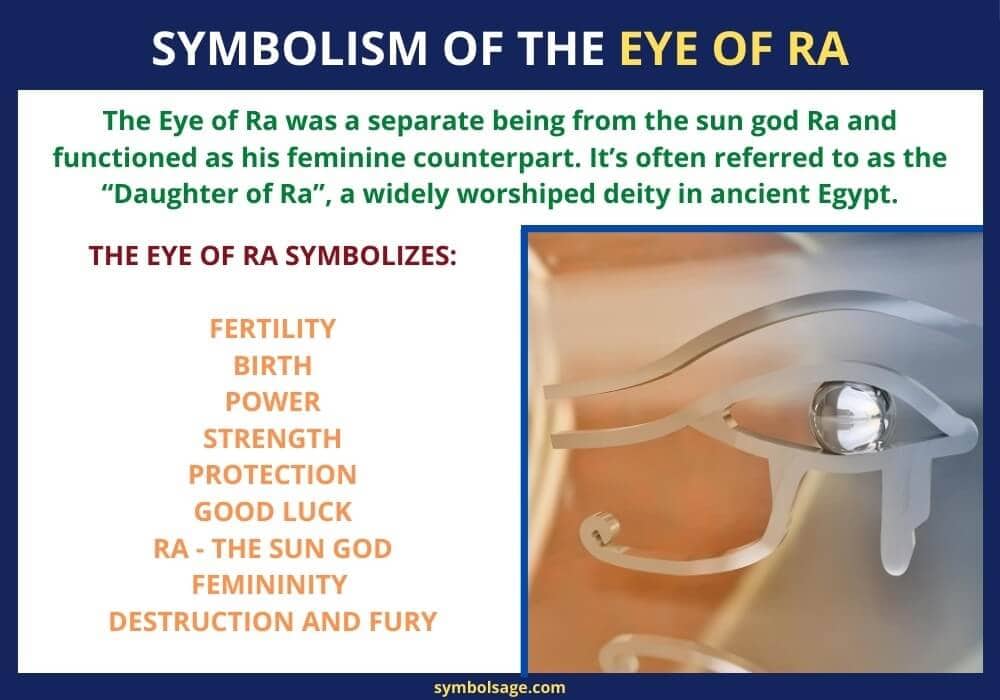
The Eye of Ra in Jewelry and Fashion
Many designers pay homage to the rich culture and history of Ancient Egypt with pieces full of symbolism. Though commonly worn as a lucky charm or amulet, the Eye of Ra is used today on clothing, caps, and even tattoo designs, and is now seen as something fashionable and trendy.
In jewelry design, it is often featured on hand carved wood pendants, lockets, medallions, earrings, bracelet charms, and cocktail rings, depicted with other Egyptian symbols. These can be minimalist or maximalist in style, depending on the design.
Wrapping Up
In ancient Egypt, the Eye of Ra was a representation of protection, power, and royal authority. Nowadays, it remains a protective symbol for many, keeping evil and danger at bay.






